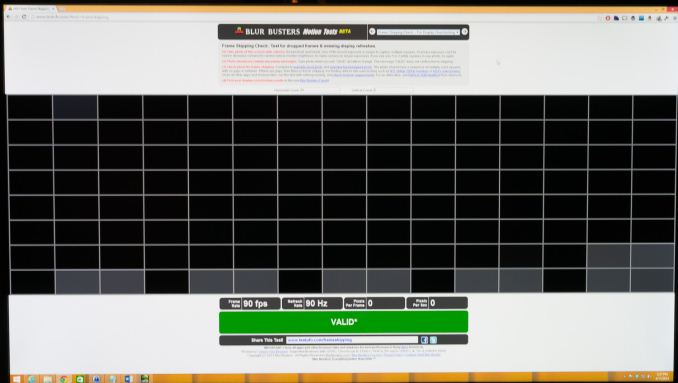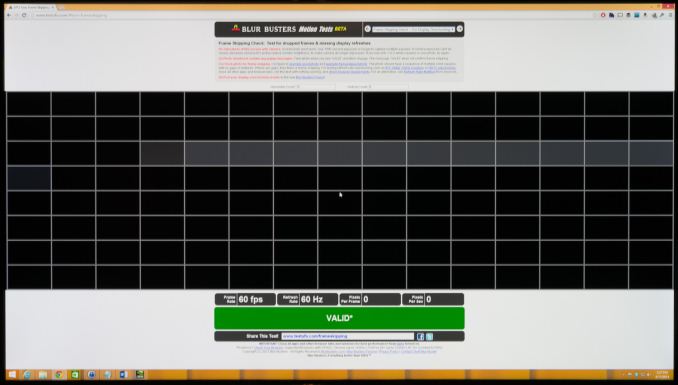QNIX QX2710 LED DPmulti True10 Review
by Chris Heinonen on April 11, 2014 6:00 AM EST_678x452.jpg)
The best thing to happen to the computer monitor marketplace has been the introduction of inexpensive QuadHD displays from South Korea. At a time when a $700 monitor was considered cheap in the United States, these were available on Ebay for around $300 and utilized the same panel as more expensive offerings, though often with a lower grade panel. The introduction of these displays forced mainstream vendors in the USA to introduce more affordable models, and saw other vendors introduce more affordable products as well.
As good as this introduction has been for consumers, I always held back from recommending the displays to most people. One reason is that as an imported product that lacks a US distributor, there was very little warranty associated with them. If you received a model that had issues from a seller on Ebay, the service or replacement options you could expect were really up in the air.
Second, there was no real testing being done on them. A review sample of a foreign, imported product was impossible to get, and just buying them to test isn’t feasible. Now I finally have been offered one of these displays to test, the QNIX QX2710 LED DPmulti True10 (henceforth called the QNIX in this review). With an updated 10-bit panel and a DisplayPort input, it offers more spec-wise than the previous models. Instead of being limited to a DVI input, it also includes DSub, DisplayPort, and HDMI inputs. The panel is a 10-bit model which it accomplishes by being 8-bit with A-FRC to simulate the last two bits. Taking full advantage of a 10-bit panel is hard to do and is usually limited to just a few applications, but being true 8-bit is important.
There is an on-screen menu system that offers adjustments for Brightness and Contrast, color temperature, and a dynamic contrast mode. Enabling the Dynamic Contrast mode disables the Brightness and Contrast controls, while also setting the light output to a retina-searing level. Navigating the menu system is pretty easy overall, though not at the level of the best displays.
There is a pair of 5W speakers built into the rear of the display and they sound like most speakers on the rear of a monitor. Sound is muffled and they’ll work in a pinch, but I wouldn’t want to use them on a daily basis. One semi-interesting feature is that the QNIX can accept a 4K input and then it scales it to 2560x1440. I don’t see a reason to do this with a PC, but with a video device (i.e. a future 4K Blu-ray player, or a video game system) where your output choices are limited to 4K or 1080p, the downscaled 4K image could look better on the QNIX than upscaled 1080p.
The specs suggest that the QNIX can be overclocked to 120Hz by using a custom resolution setting for the video card, but I am unable to make it work in any configurations that I've tried (DisplayPort or DVI, AMD or NVIDIA cards). Going to 110Hz worked fine, but higher settings did not for me. It might be a panel lottery, where some work at 120Hz and some do not, but I wouldn’t assume you will get 120 Hz to work for certain. Still, pushing beyond 60Hz is at least possible.
Update: Commenters pointed out that the QNIX "overclocks" by dropping frames. To test this I used the QNIX on TestUFO.com at both 90Hz and 60Hz and took 1/5 second exposures of the Frame Skipping Check. Below you can see screenshots showing that at 90Hz, the QNIX is simply dropping frames instead of creating extra frames. At 110Hz I began to get sparkles on the screen, obviously pushing the limits of what the panel can do. Because of this, I'd discount any overclocking mentions from the QNIX as it isn't a true higher referesh rate panel.
The monitor stand offers only a tilt adjustment, with no height, pivot or swivel. A nice design cue is the inputs being on the side of the monitor and not on the bottom. Placing them on the bottom makes hooking things up hard and I wish fewer companies would do it, particularly on budget models with no height adjustment.
| QNIX QX2710 LED DPmulti True10 | |
| Video Inputs | HDMI 1.4a, DisplayPort, DVI, Dsub |
| Panel Type | AHVA |
| Pixel Pitch | 0.231mm |
| Colors | 1.07 Billion |
| Brightness | 350 cd/m2 |
| Contrast Ratio | 1000:1 |
| Response Time | 4ms GtG |
| Viewable Size | 27" |
| Resolution | 2560x1440 |
| Viewing Angle (H/V) | 178 / 178 |
| Backlight | LED |
| Power Consumption (operation) | 46 W |
| Power Consumption (standby) | 0.5 W |
| Screen Treatment | Anti-Glare |
| Height-Adjustable | No |
| Tilt | Yes |
| Pivot | No |
| Swivel | No |
| VESA Wall Mounting | Yes, 100mm VESA |
| Dimensions w/ Base (WxHxD) | 25 3/8" x 18 1/2" x 6 3/4" |
| Weight | 10.2 lbs. |
| Additional Features | 3.5mm stereo in, 3.5mm stereo out, 2x5W speakers |
| Limited Warranty | 1 year |
| Accessories | 3.5mm audio cable, DVI cable, power adapter |
| Price | Around $365 via eBay |


_thumb.jpg)
_thumb.jpg)
_thumb.jpg)
_thumb.jpg)
_thumb.jpg)
_thumb.jpg)
_thumb.jpg)
_thumb.jpg)
_thumb.jpg)
_thumb.jpg)
_thumb.jpg)
_thumb.jpg)










85 Comments
View All Comments
Communism - Friday, April 11, 2014 - link
The X-Star DP2710 is a Samsung PLS display.The one reviewed is an AUOptronics AHVA display.
Therein lies the difference.
tbonanno - Monday, April 14, 2014 - link
Where did you hear that? Every site I see the display port version for sale it says Samsung PLS as well.okashira - Friday, April 11, 2014 - link
Your DP2710LED is superior to the reviewed monitor:-better contrast
-better uniformity
-better colors
-overclockable
-no input lag
Folterknecht - Friday, April 11, 2014 - link
Please use metric system for measurements or at least also list them. After all anandtech deals with technical gadgets and not with flour, sugar and wood.Ubercake - Friday, April 11, 2014 - link
It's funny... Let's use the metric system to talk about a 27" (or should we say 68.58cm?) panel.mr_tawan - Friday, April 11, 2014 - link
In my case, which I live in Thailand where the standard measurements are in metric system, the screen size in general terms are in imperial. However when reporting the exact dimension of the display, the measurements are in metric. (for example Sony KDL-70W850B is 70" LCD TV, the dimension is 1,586x970x370mm).I guess this is the case in many countries as well.
There are brochures that even has the diagonal screen size in metric system written in parenthesis after the imperial one, but no one pays attention to it.
QuantumPion - Friday, April 11, 2014 - link
Also note according to the overclock.net forums, only the DVI-only panels can truly overclock refresh rate. The multi-input panels can force higher refresh rate, but they just simply drop the extra frames.cheinonen - Friday, April 11, 2014 - link
Thanks for pointing this out. I tested this today and it is the case, so I updated the review. Screenshots are included as well. I'll make sure to run that test in the future to avoid this mistake.blackoctagon - Thursday, May 1, 2014 - link
Sounds like you may want to review another (genuinely overclockable) screen, like the Overlord Tempest X270OCcoachingjoy - Friday, April 11, 2014 - link
Bought a Yamakasi 27" WQHD for ~310 USD. It's great .. except it has a dark speck just to the left of center between the panel and glass. If one concentrates on this imperfection it would drive anyone nuts. I just focus on the 310 USD and everything is fine, every once and awhile though......